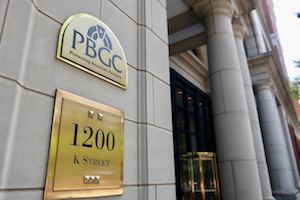Good news from the Pension Benefit Guaranty Corporation (PBGC): both its multiemployer and single-employer insurance programs are healthy, and are in an even better financial position than they were at the start of 2023.
The PBGC—which protects the retirement benefits of more than 31 million workers, retirees, and beneficiaries in the United States, collectively amounting to more than $3 trillion—on Nov. 16 released its fiscal year (FY) 2023 report, which shows that both programs’ financial condition improved this year.
Said PBGC Director Gordon Hartogensis in his message about the report, “For the third consecutive year, both PBGC’s Multiemployer and Single-Employer Insurance Programs ended the fiscal year with positive net positions.” And, he said, “Due to the improved financial position of both insurance programs in recent years, the Government Accountability Office (GAO) removed both of our insurance programs from its High-Risk List in its April 2023 High-Risk Series Report.”
The Office of the Inspector General (OIG) has given its seal of approval to the PBGC’s 2023 activity as well. The OIG contracted with Ernst & Young LLP (EY) to audit the financial statements of the Single-Employer Program and Multiemployer Program. EY found that the PBGC maintained effective internal control over financial reporting in FY 2023 and functioned in accordance with accounting principles generally accepted in the United States.
Overall
In FY 2023, the PBGC paid more than $6 billion in benefits to 917,185 participants in single-employer plans and financial assistance of more than $175.8 million to 100 multiemployer plans covering 122,082 participants. The PBGC also approved more than $45 billion in special financial assistance (SFA) to 35 severely underfunded multiemployer pension plans, which affected almost 615,000 participants.
Multiemployer Program
The Multiemployer Program protects around 11 million workers and retirees in approximately 1,360 pension plans. Through it, the PBGC provides financial assistance to insolvent plans so they can pay guaranteed benefits—which it calls “traditional financial assistance”—and “reasonable” administrative expenses.
The Multiemployer Program is financed by (1) premiums set by Congress that insured plans pay; and (2) investment income.
The traditional financial assistance the PBGC provides to multiemployer pension plans is generally in the in the form of unsecured loans, the OIG audit notes. EY says that an allowance is set up to the extent that repayment of these loans is not expected.
By the end of FY 2023, the Multiemployer Program had a net positive balance of $1.5 billion, $400 million more than its positive balance of $1.1 billion at the end of FY 2022. The report notes that the PBGC’s FY 2022 Projections Report had said that the program will probably be solvent for more than 40 years.
Part of the explanation for the Multiemployer Program’s improved solvency, the report indicates, is the existence of the SFA Program and the payments it provides. The report says that because of SFA payments made in FY 2023, the number of participants relying on the kind of assistance the Multiemployer Program provides fell: 7,483 fewer participants received guaranteed benefits and 5,383 fewer participants were eligible to receive benefits when they retire. Those participants were included in the FY 2023 counts, the PBGC says, but will no longer be receiving traditional financial assistance in future years.
Single-Employer Program
The Single-Employer Program protects about 20.6 million workers and retirees in around 23,500 pension plans. It is financed by (1) insurance premiums paid by companies sponsor pension plans; (2) investment income from plan assets for which the PBGC serves as trustee; and (3) recoveries from companies formerly responsible for plans.
When an underfunded single-employer plan terminates, the PBGC pays participants’ benefits up to legal limits. The report says that in FY 2023, 1,868 plans, covering approximately 315,540 participants, filed standard terminations with the PBGC—12% more than the average number of terminations filed in the five years before. The PBGC adds that just over 1,500 plans with more than 226,700 participants collectively completed standard terminations in FY 2023 by paying full plan benefits to participants and beneficiaries through annuities or lump sums.
By the end of FY 2023, the program had a net positive balance of approximately $45 billion, an $8 billion jump from the positive balance of $36.6 billion at the end of FY 2022.
Special Financial Assistance Program
The SFA Program was created by the American Rescue Plan (ARP) Act of 2021 to (1) help financially troubled multiemployer pension plans and (2) boost the solvency of the Multiemployer Program.
Unlike PBGC programs for which premiums are charged, the SFA program is funded through appropriations of federal funds. At the end of each fiscal year, any unused SFA funds that had been appropriated must be returned to the U.S. Treasury.
The PBGC must process SFA applications within 120 days of receiving them. Unlike the traditional financial assistance loans the PBGC provides to multiemployer plans, SFA is a transfer of funds, and the recipient plans are not obliged to repay them. However, notes the OIG analysis, plans that receive SFA funds are required to repay any traditional financial assistance they had received from the PBGC.
In FY 2023, the PBGC “made substantial strides” in the program “in adherence to the provisions of the American Rescue Plan Act of 2021,” said Hartogensis. He called the program “pivotal in ensuring that millions of America’s workers, retirees, and their families receive the pension benefits rightfully earned through years of dedicated service.”
“Our unwavering dedication extends into the future, ensuring the realization of the SFA Program’s objectives in the months and years ahead,” Hartogensis continued.
Premiums
In FY 2023, the PBGC collected $4.9 billion in premiums. The bulk of that came from collection of Single-Employer Program premiums, which brought in $4.6 billion. Multiemployer Program premium collections came to $347 million.
The Big Picture
“PBGC’s achievements in FY 2023 demonstrate our steadfast adherence to regulatory compliance, customer service, and technological advancement. We remain unwavering in our commitment to securing the retirement security of millions of America’s workers, retirees, and their families,” said Hartogensis.
- Log in to post comments
